By Olivia Ramirez
September 12, 2023
All roads lead to revenue. Determine how each of your go-to-market (GTM) teams contribute to your company’s growth and revenue, and it will be key to understanding how to communicate effectively with each.
Marketing drives revenue by generating high-quality leads that the sales team can then close. So, failing to draw the connection between your upcoming webinar and how many leads your marketing team can generate kind of feels like you’re asking for favors outside of their scope of responsibilities.
Customer Success generates (and retains) revenue by guiding your existing customers in using your product, improving their customer health, and encouraging relevant paid feature and integration adoption. So, encouraging your customer success managers to drive integration adoption among their customers without any proof of your integration’s value feels like you may be putting the trust your CSMs have with their customers at risk by pushing integrations they may not need.
And even your partners
have different ways of driving revenue. Some care about premium feature adoption, while others care about software consumption or queries. Spending a 30-minute call discussing the wrong metrics will result in noncommitment from the partner that could have
been.
Previously, we spoke about how to communicate effectively with sales
and with customer success. In today’s edition of Crossbeam Insider, we’re getting the whole gang together. We’re covering:
Let’s get started.
Getting Buy-In From Product
No matter how valuable your product is, if it doesn’t work with the other tools in your customers’ tech stacks, that value has a limit. Integrations can help solve pain points for customers without the need for your product and engineering teams to invest in building new product features. They can also allow for more flexibility for your customers who prefer other tools for specific needs. But it can still be difficult to get your product team’s investment in building integrations on top of managing their product roadmap.
A few tips:
Focus on how the integrations your product and engineering teams build will help them improve the metrics they care about most, like number of active users, retention, and churn.
Do your research on the technical complexities and needs for the integrations you’re considering. Does your partner have a sandbox environment? Does your partner’s application programming interface (API) endpoints meet the needs of the use cases you’re trying to establish? Come to your meeting with your product and engineering team with information to help them understand their investment in building the integration.
Determine timelines, and be transparent. Building your integration might take six months, but you’ll also need to factor in integration maintenance after launch.
The Partnership Ask: We’d like to build this integration with our strategic partner in Q2. Does your team have the capacity for this?
What your product team thinks: Is this worth putting time aside from product and feature development? Is this integration one that our customers want and need? How will the integration impact our product?
What you should say instead: We’d like to build this integration with
X
platform in order to provide our customers with the Y and Z
functionalities that our customers have been asking for. A large number of our customers have asked about this functionality specifically, and the majority have asked for an integration with this particular platform.
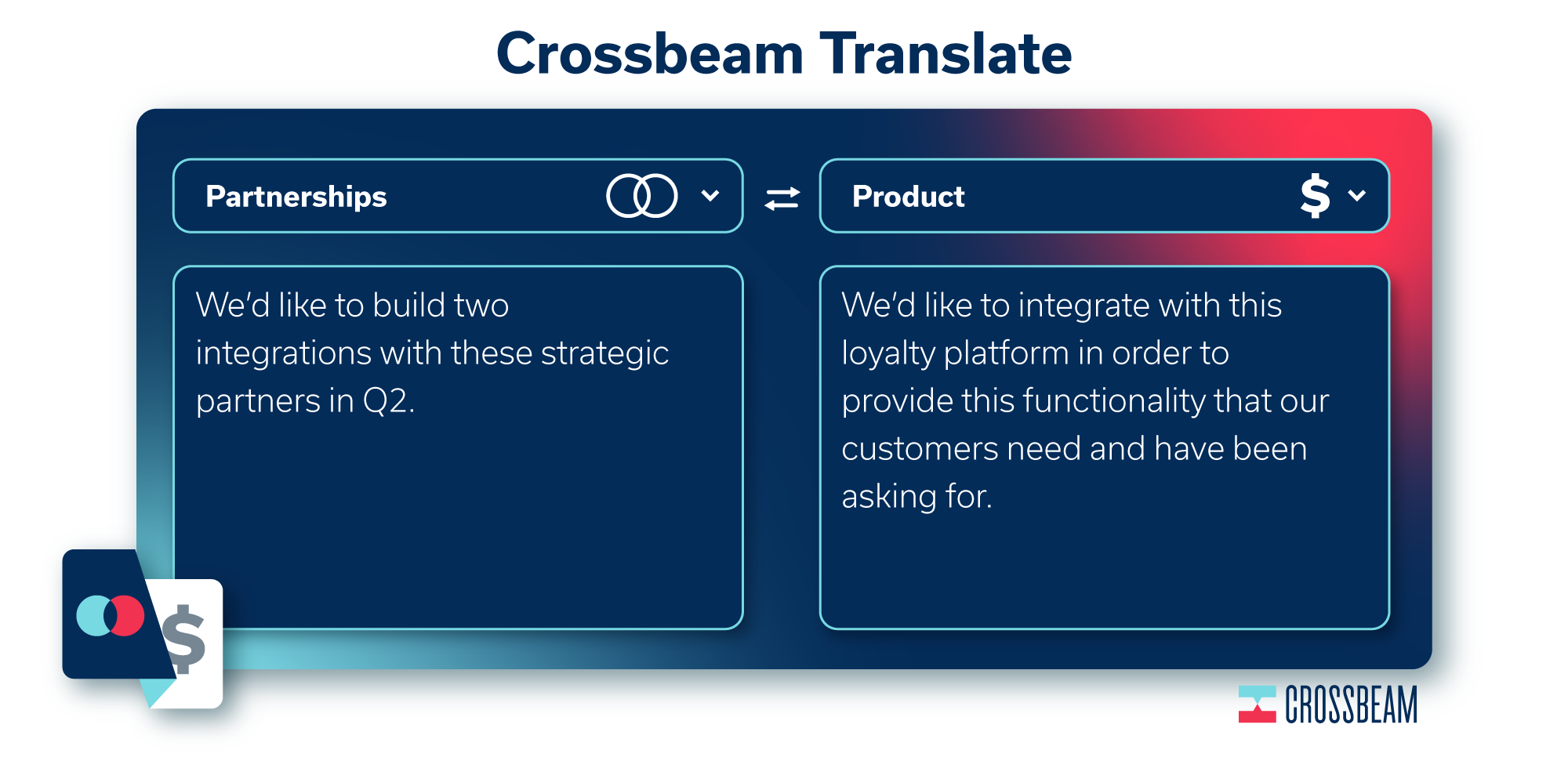
Always include data in your ask. In Sara Du’s talk at Supernode 2023, the Co-Founder & CEO of Alloy Automation
share some of the questions that are top of mind for product managers. Consider including data and insights on how your customers will ultimately use the integration. You can gather these insights from your CSMs or directly from customers.
You can also analyze data around your closed-lost opportunities and customers who churned to determine which prospects and customers said “no” due to a lack of the functionality your integration will provide. Remember: data from a subset of high-value customers can be equally important as data from a large number of customers.



During Du’s talk, she also recommends checking the product roadmap and approaching your engineers when they have less interesting work on their plate. Integrations can be exciting work, especially when your engineers are in the middle of doing more slow and tedious work, like creating documentation for product features.
92% of partnership and sales teams say that engineering timelines and integration roadmaps sometimes or often block them from building more strategic partnerships
that drive revenue.
However, Du say, “Once you’ve built respect among your peers, they will help you get integrations done because it becomes more interesting work.”
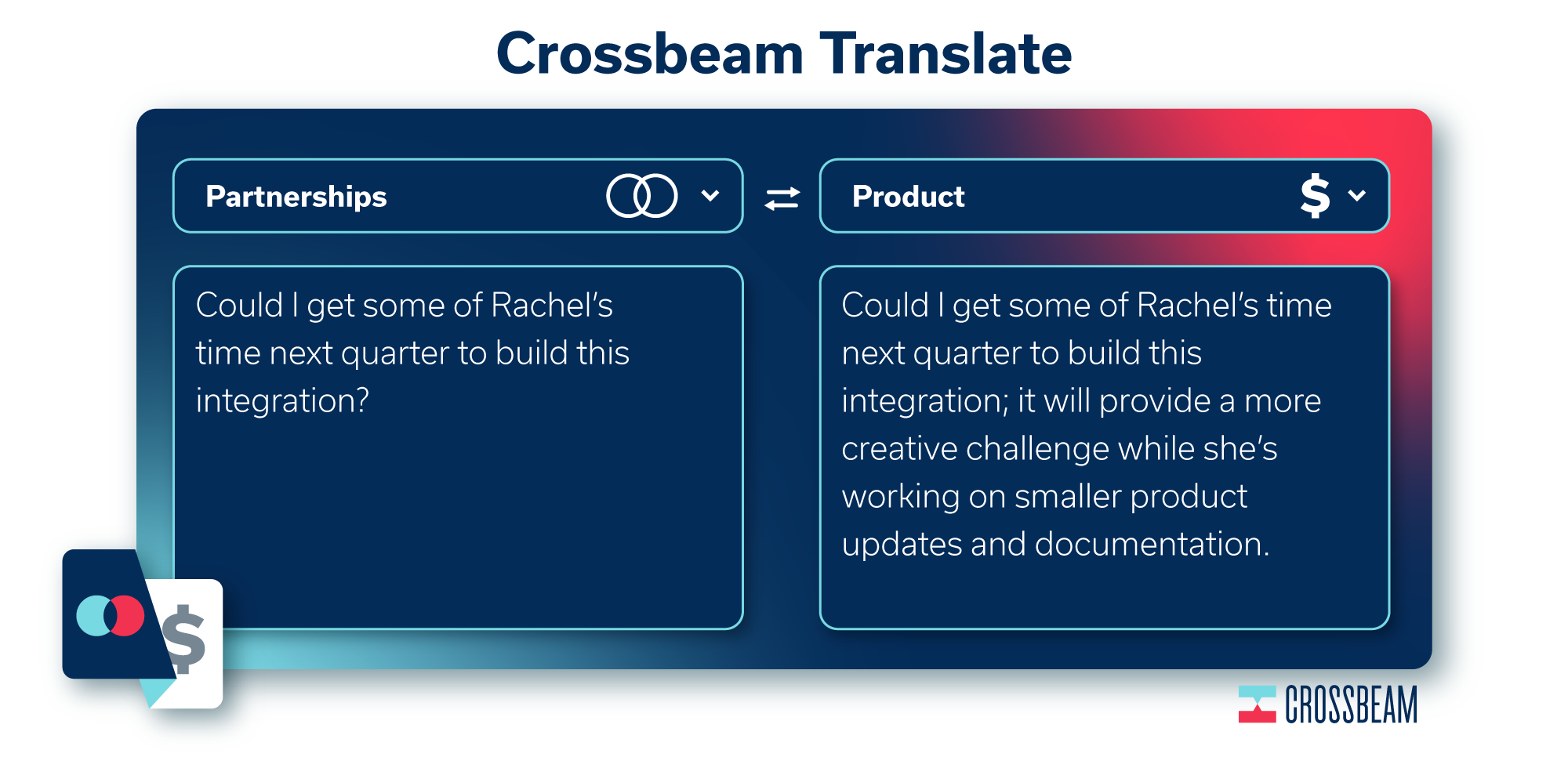

When customers pull your data into other tools in their tech stacks, your data can help fuel the work of more stakeholders in the company, in addition to the product user. For example: If the marketing team typically uses your product and pushes your data into sales tools, your product becomes more valuable for sales and for the entire company. When your integrations can help increase product activity or data consumption, your customers become less likely to churn.

Be transparent about how long the integration development process might take and the resources you’ll need after the integration’s launch.
“Setting up integrations might take two, three sprints, but maintaining integrations is forever,” says Du.
In August 2022, the team at Bynder, a digital asset management (DAM) software, shared how their tech and system integrator (SI) partners didn’t provide technical support for their integrations post-launch prior to shaking up their internal processes around integrations. This resulted in low-quality integrations that didn’t meet the expectations of their customers. Following the shake-up, their tech and SI partners now provide quality assurance (QA) post-launch, and their customers are happy.
A lack of integrations can also prevent your customer base from growing. Gather data from your prospects and customers, as well as your partners’
customers.

When discussing the timeline of building and maintaining your integrations, it’s also helpful to make your product and engineering team aware of the internal support you’ll provide them with. Identify which internal stakeholders will need to contribute to the success of the integration, including its development, liaising with your partner’s team, promoting the integration to prospects, and more.
When we launched our Tech Ecosystem, we developed an Ecosystems Team to manage every aspect of the launch. You should do the same for individual integrations in order to ensure everyone knows their responsibilities and that each piece has a corresponding stakeholder with relevant expertise. Informing your engineer about each member of the team will help assure them that they’re contributing to an initiative that the entire team is advocating for.

Learn more about how integrations and partner data can improve your product strategy.
Getting Buy-In From Marketing
Your marketing team runs a lot of marketing campaigns. Don’t be surprised if when you ask them to collaborate with a partner on another webinar, event, or email campaign, they don’t jump at the idea. They may have already planned various campaigns for the year and could even be nervous about getting credit for leads from partners.
A few tips:
Validate that the effort is worth it using data
Ensure each stakeholder knows their responsibilities and deadlines (including your partners)
Make sure not to distribute the work unevenly, leaving your marketing team with the biggest lift
The Partnership Ask: Could we collaborate on these co-marketing plays with our partner for the remainder of the year?
What your marketing team thinks:
How much work will our partner be contributing? This sounds like it could be a lot of work on top of our typical responsibilities, and it may not generate enough leads to warrant the effort.
What you should say instead: This partner generated six qualified leads last quarter with minimal effort, and five already closed. I’d like to replicate this and run a few bigger co-marketing plays to generate significantly more leads and help you meet your MQL target.
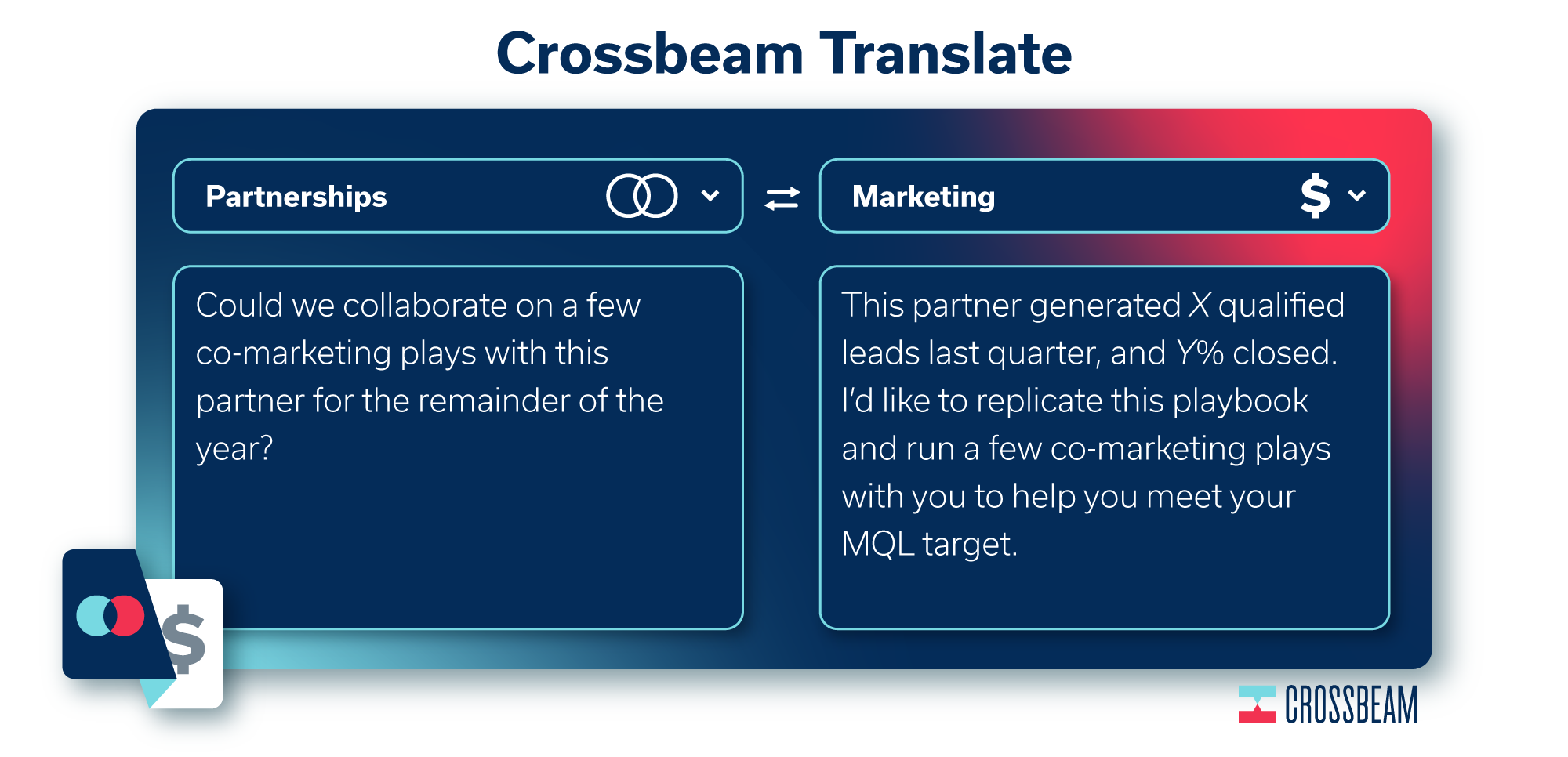

A few ways you could validate the effort prior to bringing your marketing team in:
Run a micro co-marketing motion
and track the engagement and lead generation (like mentioning your partner in your newsletter and vice versa).
Analyze the percentage of prospects who have asked for an integration
or joint solution with your partner. You can gather data from your sales conversation tool (like Gong) or by checking in with your sales team. Alternatively, analyze the percentage of prospects who have asked about a particular functionality and use case using your product that you wouldn’t be able to solve without the integration/partner.
Identify the number of mutual prospects and opportunities
you have in common with your partner using Crossbeam. You should also think about how your partner can help you generate leads from their existing customer base.

in Crossbeam showing prospects who are your partner’s open opportunities
Additionally, you should share with your marketing team how you plan to track lead generation with your partner and ensure the marketing and partnerships team receive credit. Will you use Urchin Tracking Module (UTM) links to track where your leads are coming from and through which initiative? Will your sales team tag the lead as partner-sourced or partner-influenced in your customer relationship management (CRM) system? Discuss these options with your marketing team to ensure you can trace any leads and revenue generation back to your collaborative efforts.
The Partnership Ask: We’d like to run an event with this strategic partner in Q3. Could your team help produce the event?
What your marketing team thinks: In-person events can be very expensive. Is this cost-effective? How can we guarantee attendance? Will this partner bring leads to the event? We need to make sure this is worth the effort of producing an event.
What you should say instead: We’d like to target these strategic accounts with these specific sales reps. These accounts live in this particular region, and they’re already customers of our partner. We’ve spoken with our partner, and they have campaigns in place to encourage their customers to attend and to introduce them to our sales reps at the event. We anticipate generating
X
high-quality leads from this event with a forecasted annual recurring revenue (ARR) of $Y
attributable to marketing and partnerships.
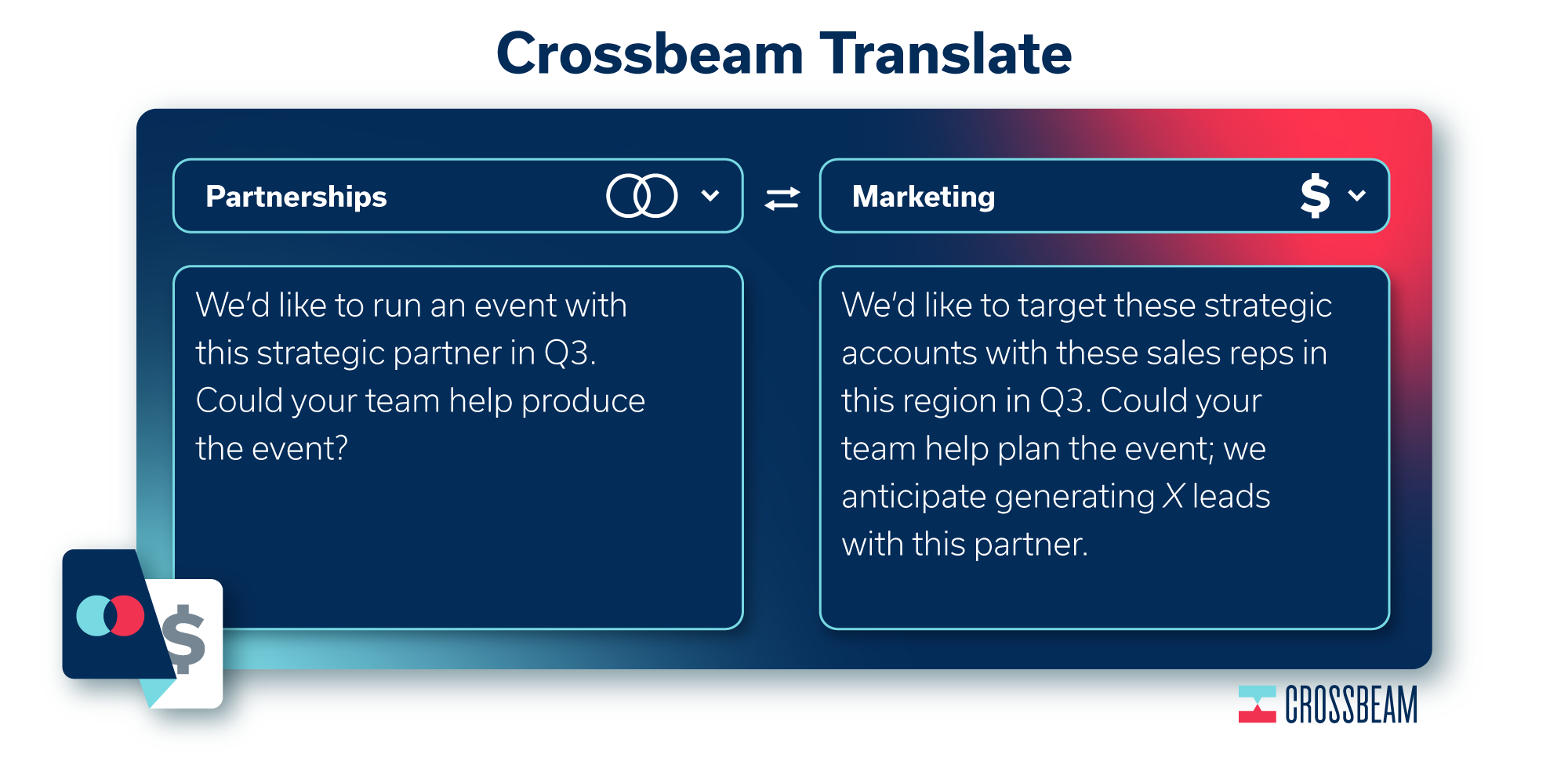
Check out how Fivetran’s
partnerships and marketing team plan small regional events with their partners
to help their sales team close a narrow list of their target accounts each quarter.

Want some inspiration for your upcoming co-marketing campaign with your partner? Read about the co-marketing flip
and how to keep your partners and internal teams accountable.
Getting Buy-in From Sales
It can be challenging to ask your sales team to adopt a new way of selling. When they typically sell competitively, selling collaboratively with partners may not sound appealing at first. But we’ve seen how deals close 46% faster
with partners and are 53% more likely to close. Once your sales team sees how partners can help them hit their revenue targets, there will be no looking back.
Below are a few examples for how to communicate effectively with the sales team. For additional examples, check out the sales edition of this article.
The Partnership Ask: Could you show our partner’s sales rep how you closed the deal with X
customer?
What your sales team thinks:
I don’t have time to spend with our partners’ sales reps when I’m trying to hit my goals for the quarter. How will speaking with my partner’s sales rep help me, and how does it tie in with my responsibilities?
What you should say instead:
This partner brought us X
amount of deals last quarter that closed for $Y
average order value (AOV). If you spend time speaking with our partner’s sales rep about how you closed Y
deal, they’ll share their win with their leadership team and you’ll be top of mind when new opportunities come along.
Take a look at the accounts your sales reps need help with, and see which accounts they have in common with your partner’s sales rep. Knowing that your partner’s sales rep targets similar customers, verticals, and regions can help encourage your sales rep to develop a strong relationship with your partner’s sales rep. Ultimately, they can schedule recurring calls
to determine how they can help each other out each quarter.
Additionally, sharing data around the close rate, deal size, or other sales-related metrics of success with the partner will help your sales rep understand the value of your partnership. When they see the results themselves, they’ll understand the impact of co-selling
with partners and the benefit of working with them on more of their opportunities.
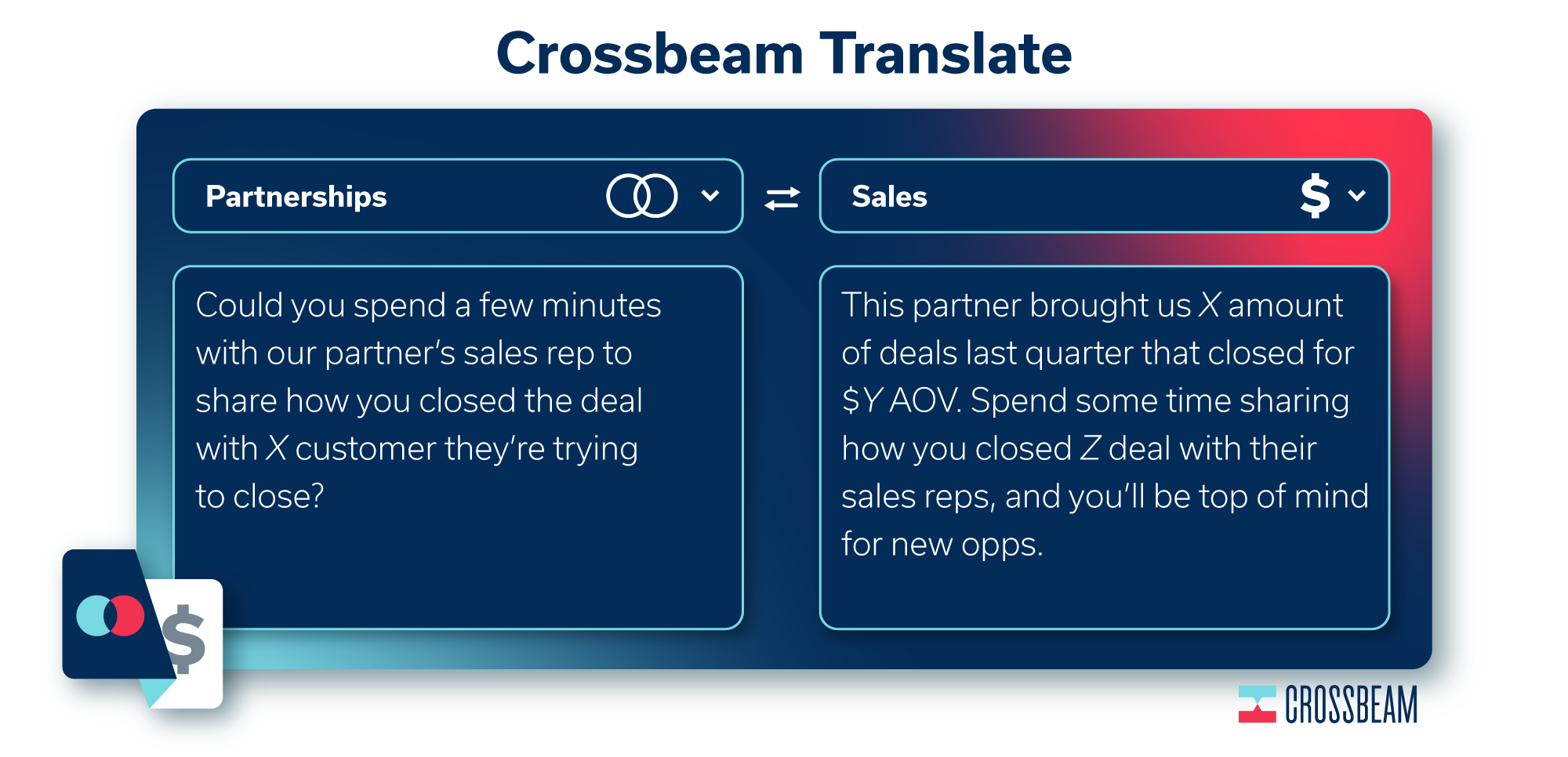
The Partnership Ask: Work with this partner to close your open opportunities.
Again, referencing metrics of success from a particular partner, even if it’s only for a small number of deals so far, can help your sales rep think about how to replicate that same success.
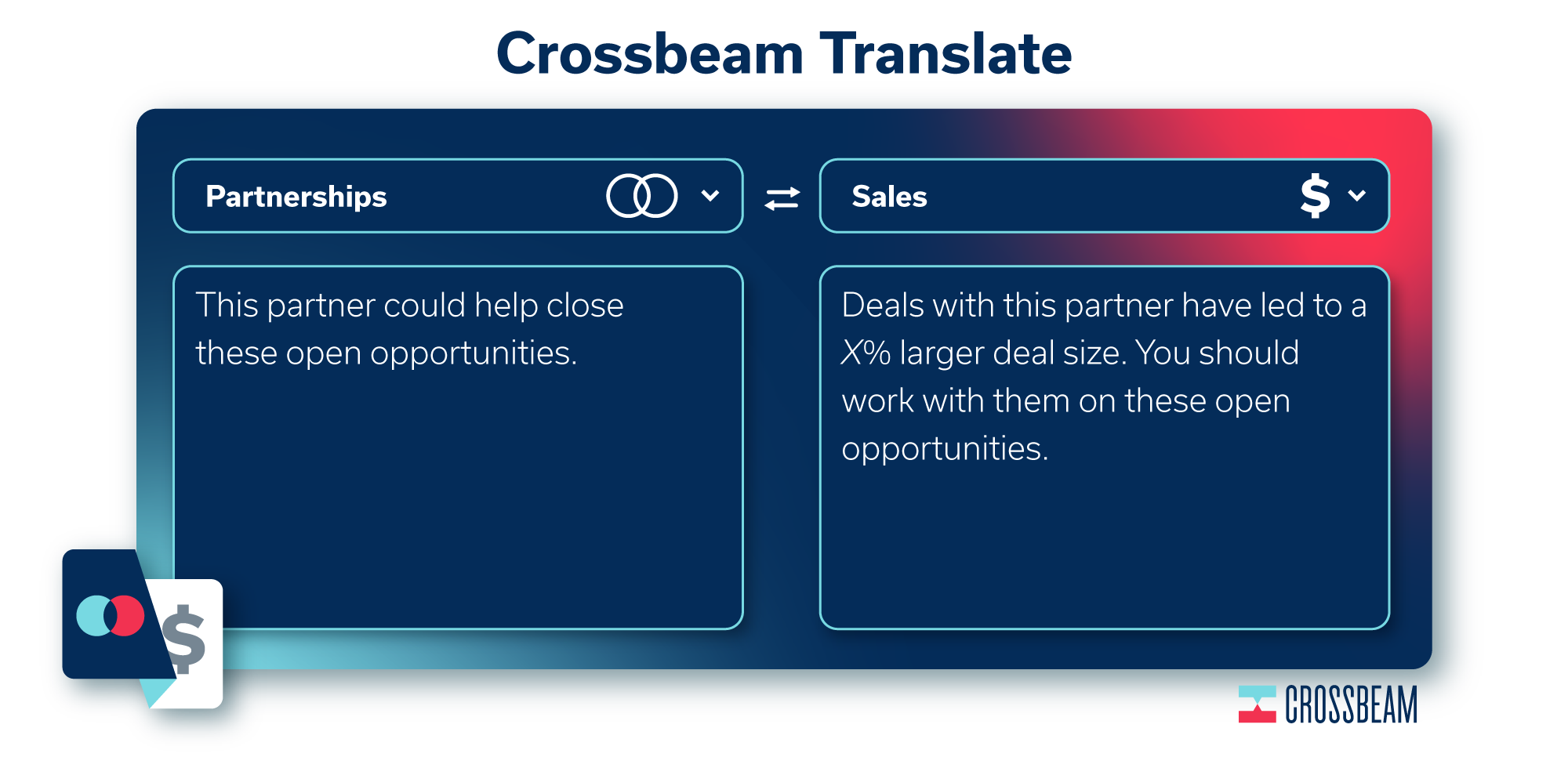
If you’re using the Crossbeam Full Salesforce Widget
or the Crossbeam Starter Salesforce Widget, your sales reps can see exactly which partners can help influence an opportunity directly in their account dashboard.

If not, come ready to talk about a list of your sales rep’s accounts using Crossbeam data. You can start using Crossbeam for free, and filter your reports
with partners by your sales rep’s name, by region, and more.

in Crossbeam
showing the number of open opportunities you have in common with your partner’s customer list
The Partnership Ask: Where did you leave off working with the partner on this account?
What your sales team thinks: The partnerships team is pressuring me to work with this partner even though they’re not helpful. They don’t trust me to work on the account on my own (or with the partner) without supervision.
What you should say instead: What’s the status of this opportunity? If the partner isn’t helping, I’d like to find someone who can. If you’re making progress, I want to celebrate that with the team!
Show your sales rep that you care how your partner is performing. If your sales rep isn’t happy, you’re willing to advocate on their behalf and get them the help they need from another partner or different partner sales rep.

For more “Crossbeam Translates” examples for sales, check out How to Communicate Effectively With Your Sales Team About Partnerships.
On average, more than half of sales reps co-sell with partners. If your sales reps are hesitant to co-sell, here are a few articles that can show how valuable partners can be for hitting their quotas and showing leadership potential:
Getting Buy-In From Customer Success
Your agency and channel partners can help ensure your customers get the most out of your product. Your tech partners can also help guide your customers, and integration users are 58% less likely to churn
on average.
Your customer success managers (CSMs) should be the first stakeholder you go to to encourage integration adoption. But send low quality integrations their way, or encourage adoption to the wrong customers, and you put their relationship with their customers at risk. It’s important to build and launch your integrations thoughtfully so the customers who need them can use them to get more value out of your product. As a result, your product becomes “stickier” and your net revenue retention (NRR) number grows.
The Partnership Ask: Could you drive integration up for these accounts that might churn?
What your customer success team thinks:
Encouraging integration adoption for some of these accounts might sour our relationship even more. Are these integrations right for these customers? Will they help them solve the pain points they were having that increased their likelihood of churning?
What you should say instead: We’ve tracked that our customers who have adopted three integrations or more are X% less likely to churn. We’ve compiled a list of your customers with less than three integrations and who are at risk of churning, and I’ve jotted down the integrations most relevant to their needs. These are the use cases most relevant to them.
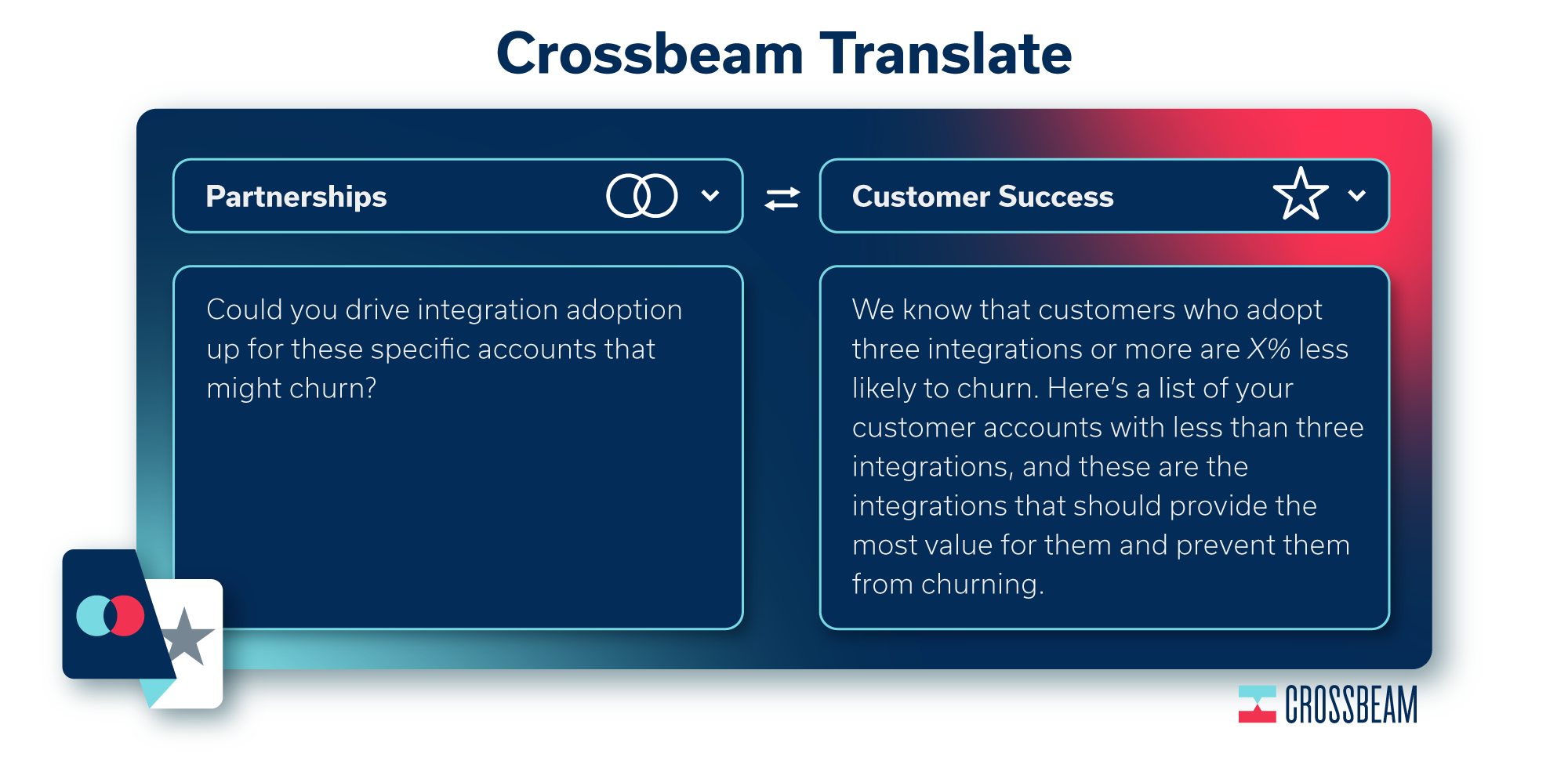
The Partnership Ask: Could you identify integration adoption opportunities for your new customers and recommend the integrations in your “new customer kickoff” meetings?
What your customer success team thinks: It will take me hours to sort through each integration and decipher which ones might be relevant to our customers. Could you provide some guidance here?
What you should say instead: We took a look at your upcoming “new customer kickoffs” and put together a list of the integrations that would be most relevant to each of your customers. We’ve also put together some success stories and use case examples that may be relevant to their needs. Let us know how it goes and if there are any other integrations that come up during your meeting that we should prioritize in our integration roadmap.

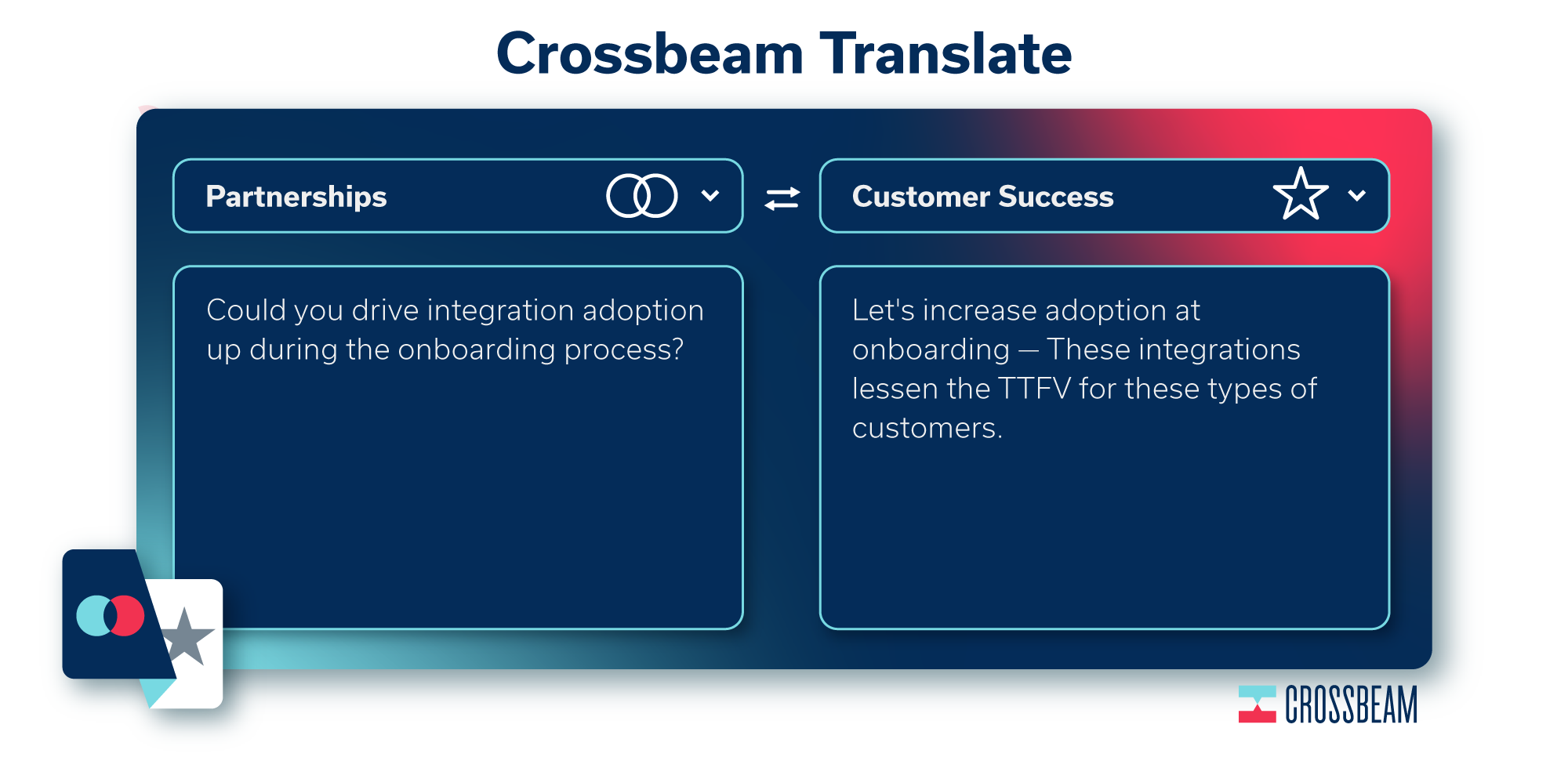
For more “Crossbeam Translates” examples for customer success, check out How to Communicate Effectively With Your Customer Success Team About Partnerships.
Getting Buy-In From The C-suite
The Partnership Ask: Could we get an additional $X Million to invest in this partnership?
What your C-suite thinks: Do we have data showing that this partnership contributes a repeatable source of revenue? What results have we seen from the partnership so far? What results can we anticipate with this type of budget allocation?
What you should say instead: We saw X% of opportunities in our target market close with this partner. Could we get an additional $Y Million in budget to expand our customer base with this partner? There’s $120 Million in potential revenue
attainable with our partner through their existing customer base and more in mutual and net new opportunities.

In Blake Williams’s Supernode 2023 talk, the CEO of Ampfactor shared how you can allocate a small monetary investment in co-marketing motions to validate the impact of a partnership. Then, you can use the results to get buy-in for a much larger investment that you wouldn’t have been able to get without the data to help make your case.
“The board gets it,” says Blake Williams, CEO of Ampfactor. “They’re like, ‘Oh, fantastic. You’re putting programs around the revenue that’s latent, lying there in these partnerships that you’ve formed these relationships on.”
“We want to make it investment-interesting, not anecdotally-interesting. The fact that you brought in a whale, that’s awesome, but no one can invest in that random act,” says Williams.

In addition to data around revenue generation, think about the big picture of what your partnership can help your business achieve. If your partner can help you access a new market or vertical, analyze the opportunity at hand and gather early metrics of success to validate the partnership to your leadership team.
Partner-sourced revenue
is the most popular key performance indicator (KPI) for partnership teams, and with good reason. Influenced opportunities, leads, and integration adoption are all important metrics to track, but if they don’t contribute to revenue, then they’re falling short of the ultimate goal. A high percentage of leads from partners is great, but not if they don’t close.
When speaking with your C-suite or the board, always do your best to tie your partnership efforts back to revenue.
In Braydan Young’s 2023 Supernode talk, the Chief of Alliances at Sendoso shared how the CEO and the board only care about revenue.

Keep tracking influenced pipeline, but when communicating with the board, share how much “closed-won” revenue your partnerships contributed.
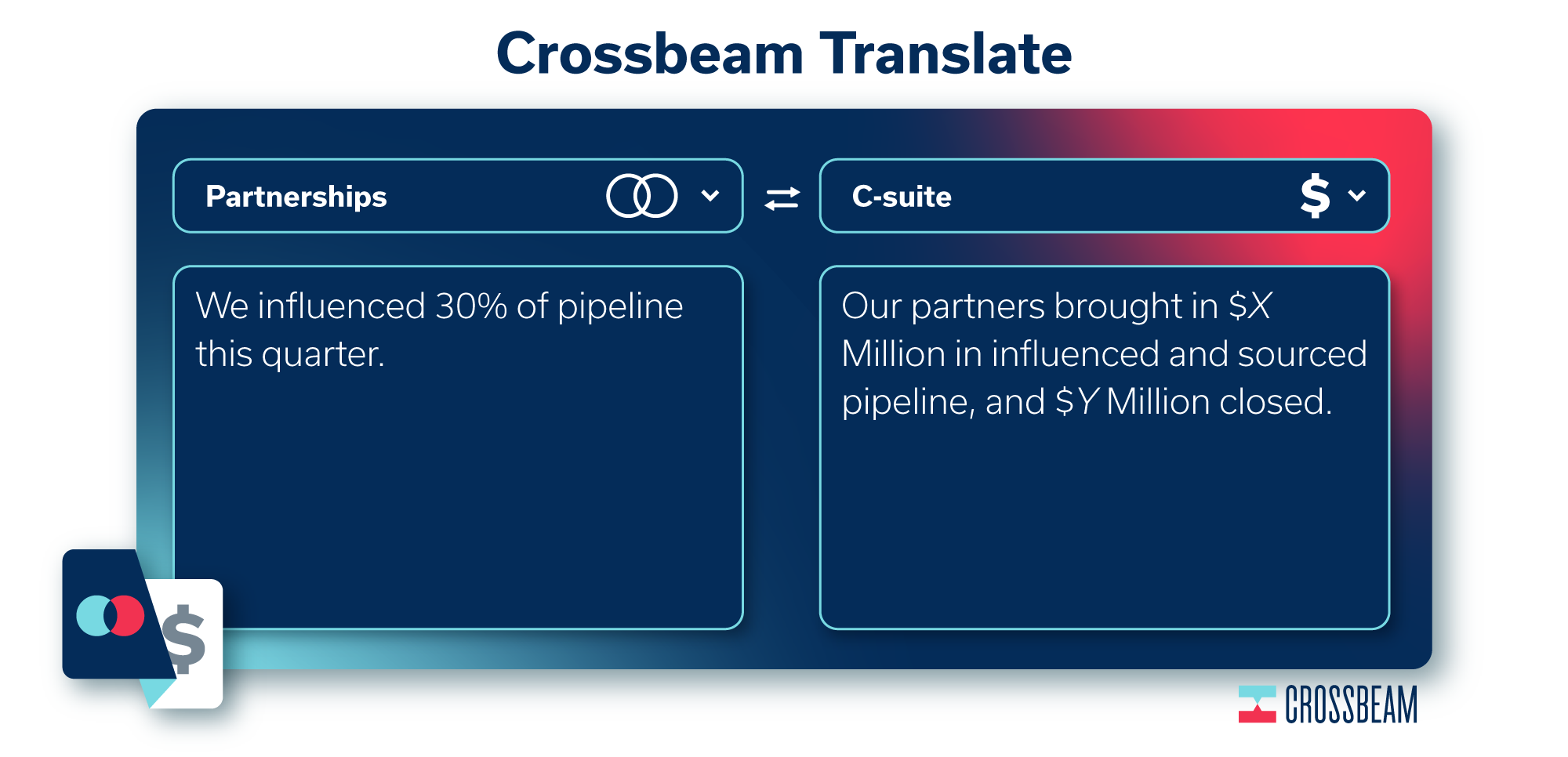

By observing and showcasing the revenue you generate with partners, you can get buy-in to increase your headcount and get more resources. At 8:45 in Young’s Supernode talk, he speaks about the 5X rule
and how to use it to get more headcount.

Getting Buy-In From Your Partners
You get on the phone with your partner and immediately let out a sigh of relief. You’re both in the partnerships world and you just get each other. But then you start talking about the metrics you’re tracking, and your partner loses interest.
What your partner tracks and what you track don’t always align, but your partnership can still help you achieve your respective goals.
The Partnership Ask: We’ve seen a significant uptick in integration adoption and an increase in active users for those who have adopted our integration. We’re excited about these results and would like to develop a strategic partnership.
What your partner thinks: I haven’t seen any evidence of success on my end, and I don’t care about those metrics. How does our integration benefit our growth? Where’s the proof that I should invest in a strategic partnership?
What you should say instead: We’ve noticed an uptick in queries for customers using the integration. How has our integration increased your product consumption?
Kashish Gupta, Co-Founder & Co-CEO at Hightouch, says that by gathering data, taking educated guesses, and asking their partner about their own observations, you can help your partner understand your integration’s value. Gupta and his team landed strategic partnerships
early on in their company’s maturity by building the integrations themselves and then speaking about the integration’s success in terms their partners care about.
If your partner drives revenue through product consumption, then determine if and how your integration is impacting their product consumption. If they care more about premium feature adoption, determine if there’s an uptick in your integration users adopting their premium features.
If you’re seeing the number of mutual customers you have with your partner increasing in Crossbeam, mention this data to your partner. You can even ask them how much some of your biggest customers are paying them to help them understand how your integration is driving new business.
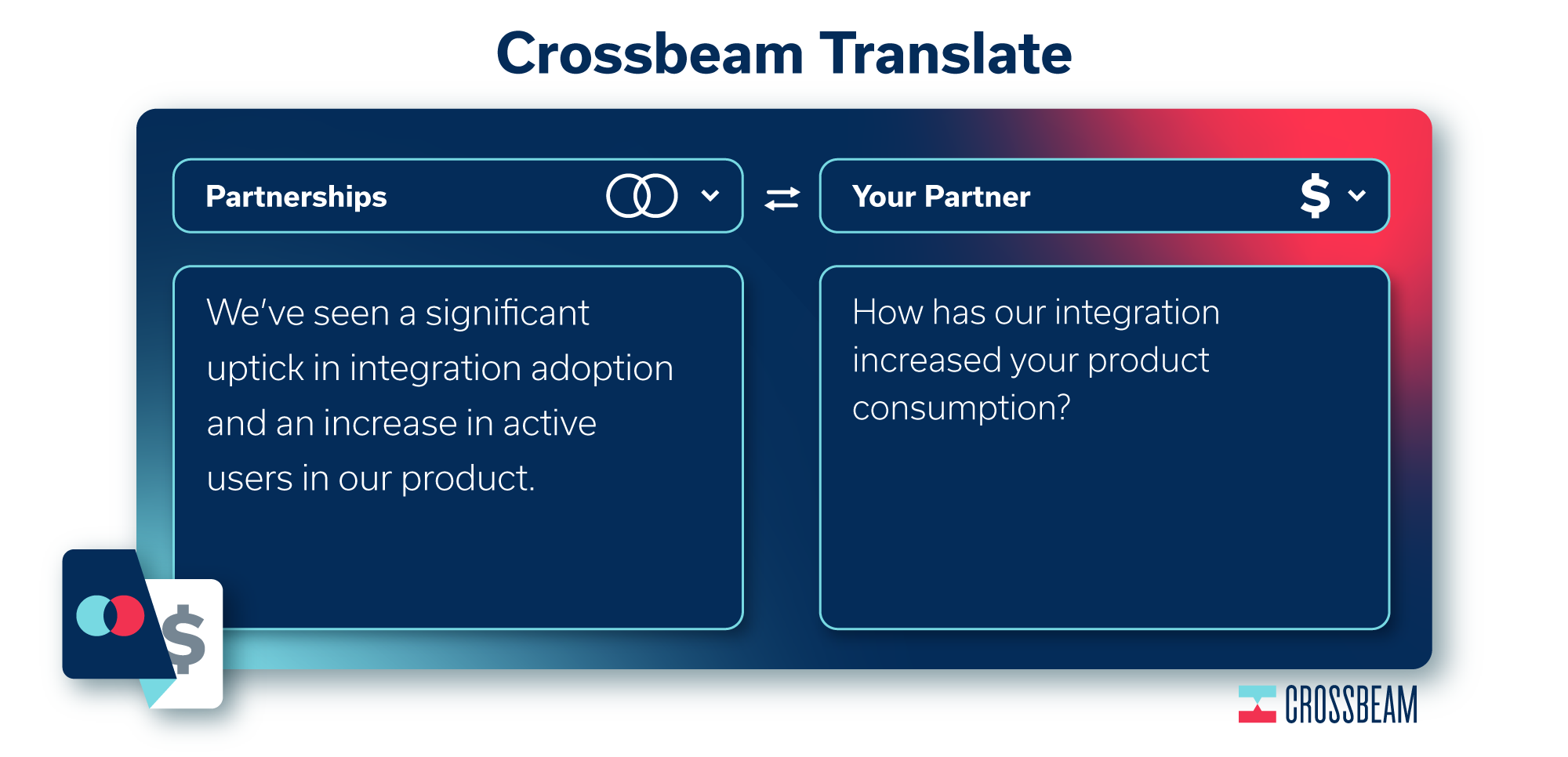
John Smit, Partner Account Manager at Siteimprove, shared how offering a kickback to your partners may elicit some quick wins, but doing so could put limits on your partnership.
“Are you setting yourself and your partnership up for success by positioning the value you deliver or markets you unlock, or are you actually underselling yourself to your potential partner network?” says John Smit, Partner Account Manager at Siteimprove.
The Partnership Ask: We’ll give you a kickback on any referrals you send our way.
What your partner is thinking: This is a low-effort partnership that I can ignore or put minimal effort into. This isn’t a strategic partnership that my entire team should invest in.
What you should say instead: We can help you break into the vertical you’ve been struggling to access. X
of your prospects are already our customers, and we think these new accounts would also be a good fit.

Speak with your partner to understand where they’re looking to improve and grow. If they’re looking to access a new vertical, identify a list of your customers in that particular vertical and how you can introduce your partner to not just one new customer but many. Show your partner how your team can provide a reliable and repeatable source of value worth investing in.

The idea of adding a new logo to your Tech Ecosystem is exciting. When planning your partner pitch meeting, think about why your partner needs your logo in their ecosystem. If you’ve heard from a large number of customers that they’re looking for a solution like your partner’s, then you could help expand your partner’s customer base significantly. You could also help them box out their competition by helping your customers choose your partner’s solution over their competitor’s.

–
Congrats! Now you’re ready to communicate effectively with each of your GTM teams. Next up: how to communicate effectively with your hairdresser (A bowl cut? Again?!). ?
While you’re here, we’re surveying GTM teams to learn how they’re adapting their strategies to account for shifts in the market, buyer behavior, and technology.
Take the 5-min survey,
and be one of the first to receive the report when it’s ready. You’ll get:
Insights into what’s working and what’s not for sales, marketing, partnerships, and customer success teams
Where GTM teams are investing more, and where they’re pulling back
Industry benchmarks to help you make the case for the most effective GTM strategies in 2024



